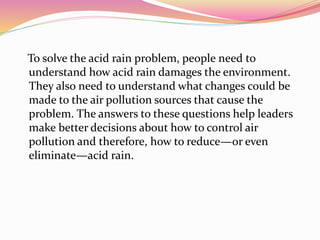This document discusses acid rain, its causes, effects, and ways to reduce it. It begins by defining acid rain as precipitation containing higher than normal amounts of nitric and sulphuric acids from both natural and man-made sources, primarily the burning of fossil fuels. Approximately 2/3 of sulphur dioxide and 1/4 of nitrogen oxides in the US come from electric power generation burning coal. The document then covers the topics of wet deposition, dry deposition, effects of acid rain, measuring acid rain, reducing acid rain, and restoring damaged environments.





















